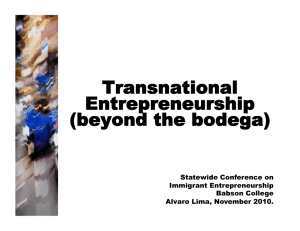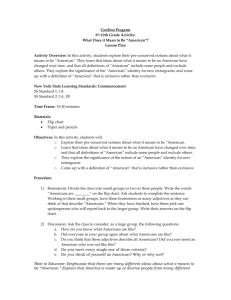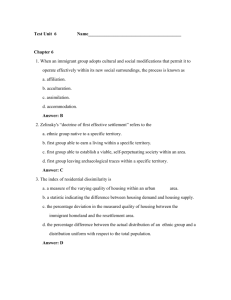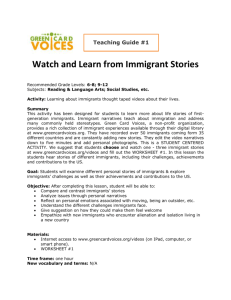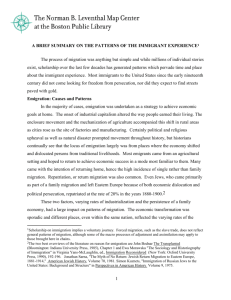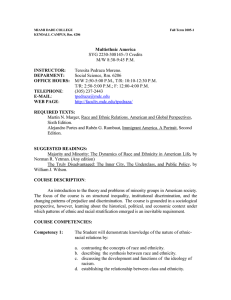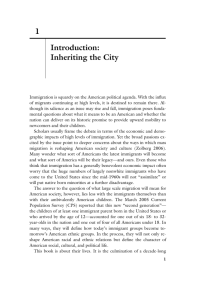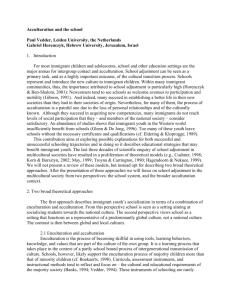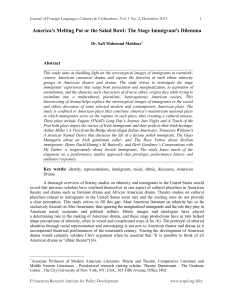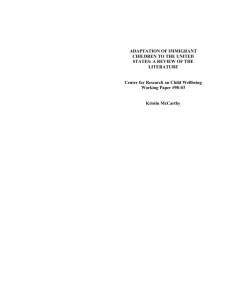SOCI 348 - Oberlin College
advertisement
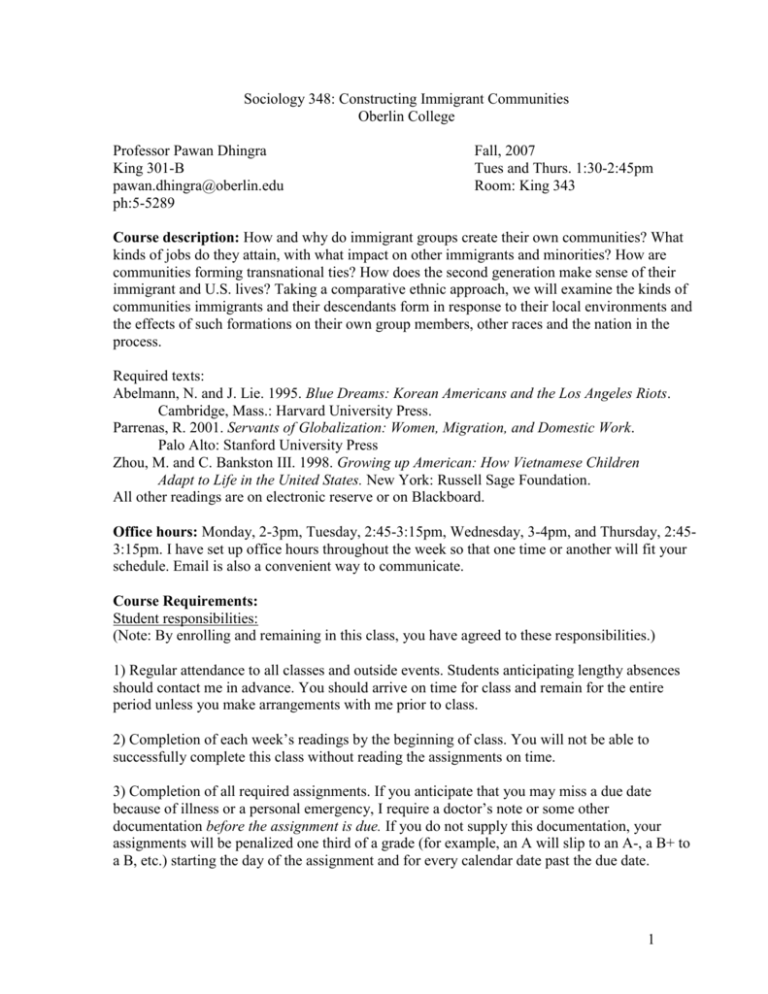
Sociology 348: Constructing Immigrant Communities Oberlin College Professor Pawan Dhingra King 301-B pawan.dhingra@oberlin.edu ph:5-5289 Fall, 2007 Tues and Thurs. 1:30-2:45pm Room: King 343 Course description: How and why do immigrant groups create their own communities? What kinds of jobs do they attain, with what impact on other immigrants and minorities? How are communities forming transnational ties? How does the second generation make sense of their immigrant and U.S. lives? Taking a comparative ethnic approach, we will examine the kinds of communities immigrants and their descendants form in response to their local environments and the effects of such formations on their own group members, other races and the nation in the process. Required texts: Abelmann, N. and J. Lie. 1995. Blue Dreams: Korean Americans and the Los Angeles Riots. Cambridge, Mass.: Harvard University Press. Parrenas, R. 2001. Servants of Globalization: Women, Migration, and Domestic Work. Palo Alto: Stanford University Press Zhou, M. and C. Bankston III. 1998. Growing up American: How Vietnamese Children Adapt to Life in the United States. New York: Russell Sage Foundation. All other readings are on electronic reserve or on Blackboard. Office hours: Monday, 2-3pm, Tuesday, 2:45-3:15pm, Wednesday, 3-4pm, and Thursday, 2:453:15pm. I have set up office hours throughout the week so that one time or another will fit your schedule. Email is also a convenient way to communicate. Course Requirements: Student responsibilities: (Note: By enrolling and remaining in this class, you have agreed to these responsibilities.) 1) Regular attendance to all classes and outside events. Students anticipating lengthy absences should contact me in advance. You should arrive on time for class and remain for the entire period unless you make arrangements with me prior to class. 2) Completion of each week’s readings by the beginning of class. You will not be able to successfully complete this class without reading the assignments on time. 3) Completion of all required assignments. If you anticipate that you may miss a due date because of illness or a personal emergency, I require a doctor’s note or some other documentation before the assignment is due. If you do not supply this documentation, your assignments will be penalized one third of a grade (for example, an A will slip to an A-, a B+ to a B, etc.) starting the day of the assignment and for every calendar date past the due date. 1 Required assignments: Attendance, and class participation: This class depends on class discussion. You are expected to attend class regularly and to participate in group discussion so that we all learn from one another. Short essay questions on the readings may be conducted to ensure that you are keeping up with the readings and to assess comprehension. Participation and prepared questions are worth 16% of your final grade. Shorter papers: There are two or three papers due during the semester, depending on whether you choose to write a research paper. If you write a research papers, you are to write two papers, and you get to choose which two. If you do not, then you must complete all three papers. Each of the short papers is about 6-7 pages. The purpose of the shorter paper is to give you an opportunity to expand on a topic tied to class themes. The format and specifics of each paper will be discussed in class. The papers may require a little outside research, but not much. The papers will draw from course readings and discussion. You are encouraged to see me and/or the writing center for assistance on the papers. If you write all three papers, each is worth 28% of your final grade. If you write two, each is worth 25%. Research Paper: You can write a research paper, about 10 pages, on a topic of your choice. You are to devise an original thesis on the group and topic you choose. The group can be historical or current, across the nation or in Northeast Ohio. It can be based on library material or primary research. You will have the opportunity to discuss your paper ideas in class. The final paper is worth 34% of your final grade. Other notes: 1) You are assumed to follow the Honors Code. Please consult your student handbook or see me for details. You will need to attest to your compliance to the honors code with each written assignment you turn in. 2) If you have a learning disability or other disability, you are entitled to assistance and accommodations through the university. Please register with the Jane Boomer , Coordinator of Services for Students with Disabilities, in Room G 27 Peters Hall, ext. 5-8467, for assistance in developing a plan to address your academic needs. Please do this at the beginning of the semester. Please notify me as well. Tentative Course Outline Sept. 4 Introduction to the course and to one another. Section I Coming Over, Finding Work Theories of Why People Migrate Sept. 6 “Who they are and why they come,” Portes and Rumbaut. 2006. Immigrant America. Berkeley: University of California Press. “Theoretical Approaches to Mexican Wage Labor Migration,” Wilson. 1997. New American Destinies, Hamamoto and Torres (eds.). New York: Routledge. 2 “Social and Legal Barriers: Sexual Orientation and Asylum in the United States,” Randazzo. 2005. Queer Migrations, Lyibheid and Cantu (eds.). Minneapolis: University of Minnesota Press. Negotiating the Labor Market Sept. 11 “Making it in America,” Portes and Rumbaut. 2006. Immigrant America. Berkeley: University of California Press. “‘Making it’ in America,” Bonacich. 1987. Sociological Perspectives, v. 30, 4:446-466. Small Business and Racial Conflict: Employers’ Perspective on Work Sept. 13 Blue Dreams, chapter 1, 3 September 18 Blue Dreams, chapter 4, 5, September 20 Blue dreams, chapter 2, 6. Familial and Exploited: Employees’ Perspective on Work September 25 “Job Transitions in an Immigrant Metropolis,” Nee, Sanders, and Sernau. 1994. American Sociological Review, v. 59:849-872. “The Industrial Division of Labor among Immigrants and Internal Migrants to the Los Angeles Economy,” Ellis and Wright. 1999. International Migration Review, v.33, 1:26-54. September 27 Sewing Women. Chin 2005. New York: Columbia University Press. Chapter 3 “Getting from there to here,” p. 47-55; Chapter 4 “The attraction of cloth”; Chapter 7 “The bottom line.” “Exploitation and Abuse in the Garment Industry,” Su and Martorell. 2002. Asian and Latino Immigrants in a Restructuring Economy. López-Garza & David R. Diaz (eds.) Palo Alto: Stanford University Press. October 2 “Upholding and Negotiating the Family Work Contract,” Song. 1999. Helping Out. Philadelphia: Temple University Press. “Relative Merits: Family Culture and Kinship in Small Firms,” Ram and Holliday. 1993. Sociology v. 27, 4:629-648. October 4 In class film: The Motel. No readings so can work on first papers and start on final research paper. 3 October 9 “The Labor Market: Immigrant Effects and Racial Disparities,” Ong and Valenzuela, Jr. 1996. Ethnic Los Angeles. Waldinger and Bozorgmehr (eds.) New York : Russell Sage Foundation. “West Indians at Work,” Waters. 1999. Black Identities. Cambridge, MA: Harvard University Press. October 11 “Bridging the Community: Nativism, Activism, and the Politics of Inclusion in a Mexican Settlement in Pennsylvania,” Shutika. 2005. New Destinations. New York: Russell Sage Foundation. Come prepared to discuss topic of final research paper for those who are doing a final paper. First paper due. Section II – Local and Transnational Community Formations Social Networks and Ethnic Community Capital October 16 and 18 Growing Up American - Introduction, chapter 4, and skim chapters 1 and 3. October 23 and 25 – Fall Break October 30 Growing Up American Chapters 6 – 9. “The Culture of Poverty Reconsidered,” Steinberg. 1989. The Ethnic Myth. Boston: Beacon Press. Transnational Families, Labor, and Sexuality November 1 Servants of Globalization, Introduction and chapter 2. November 6 and November 8 Servants of Globalization, Chapters 3-6 November 13 Servants of Globalization, Chapters 7 and conclusion November 15 “Queer Intersections: Sexuality and Gender in Migration Studies,” Manalansan. 2006. International Migration Review, v.40, 1:224-249. “Visibility and Silence: Mariel and Cuban American Gay Male Experience and Representation,” Pena. 2005. Queer Migrations, Lyibheid and Cantu (eds.). Minneapolis: University of Minnesota Press. 4 November 20 Second paper due. In class film: Miss India Georgia. November 22 – Thanksgiving Break Section III Second Generation Boundaries Ethnic Culture Retention and Reinvention November 27 “Lost in Translation,” Portes and Rumbaut. 2001. Legacies. Berkeley: University of California Press. “Identities of the Second Generation,” Waters. 1999. Black Identities. Cambridge, MA: Harvard University Press. November 29 “What is Indian about You: A Gendered, Transnational Approach to Ethnicity,” Das Gupta. 1997. Gender and Society, v. 11, 5: 572-596. “Islamic Identity Recovered: Muslim Women after September 11,” Badr. 2004. Culture and Religion, v. 5, 3:321-338. Other Trajectories: Pan-ethnicity and Transnationalism December 3 Becoming Asian American. Kibria. 2004. Rutgers: Rutgers University Press. Chapter 4 “College and Asian American Identity,” and chapter 6 “Ethnic Futures: Children and Intermarriage.” “What Shall I Call Myself?: Hispanic Identity Formation in the Second Generation,” Portes and MacLeod. 1996. Ethnic and Racial Studies, v. 19, 3:523-547. December 6 “Padre Jesus,” Smith 2006. Mexican New York. Berkeley: University of California Press “Trans-nationalism and the Children of Immigrants in Contemporary New York,” Kasinitz, Waters, Mollenkopf, and Anil. 2002. The Changing Face of Home. New York: Russell Sage Foundation. December 8 and December 13 Presentations of final papers. Third paper due December 13. Research paper due during exam period. 5

